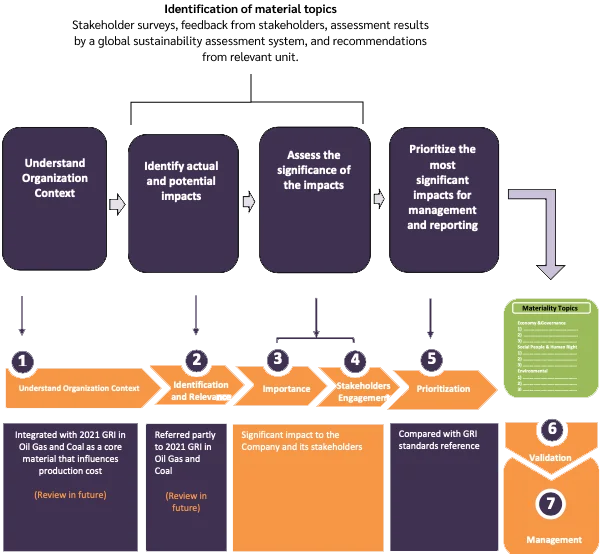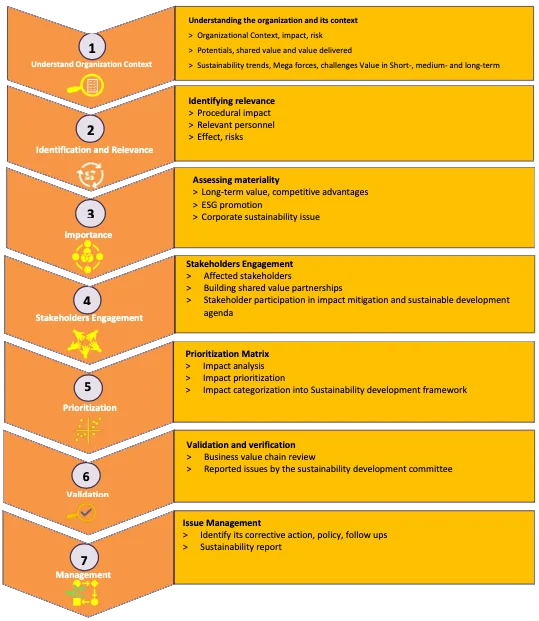
 Materiality Analysis
Materiality Analysis
The Materiality of Business and Sustainability
The consideration to identify the business's key material issues consists of economic sustainability social and environment related to the Stakeholders of the Company. Those material issues might affect the ability of business conduction and business value-creating for the Shareholders both in the present and future.
The Company considered to evaluate the material issues and to communicate the business strategies to respond to the Stakeholders expectations which is an important factor for maintaining competitiveness, creating long-term value for the organization and supporting sustainable business operations.

SUTHA Materiality and Sustainability Risk Analysis
In 2023, SUTHA prepares its sustainability report in reference to the 2021GRI standards (GRI 3: Material Topic). together with the Course S04, (Materiality and Sustainability Risk Analysis), a course sponsored by the Stock Exchange of Thailand then involves the Company sustainability management team and trained personnel, a total of 17 persons.
Defining the Materiality of SUTHA

-
Understand Organization
Context
Understanding the needs and expectations of interested parties by selecting significant issues regarding competitive advantages, long-term value and sustainability development activities in aspect of economic, environmental and social aspects as per the following;
- Internal context factors from internal parties brainstorming, including ESG and ERP (ESG and Enterprise Risk Management following COSO ERP 2017) arising from procedural risks within the supply chain
- External context factors are aspects outside the company that affect its operations, strategy, and success, such as sustainability framework guided by SET, SDGs, global trends, laws, regulations, and standards. These are grouped into a set of linked significant materiality issues.
-
Identification and
Relevance
Identify actual and potential impacts Procedural relevance within business chain from raw material procurement, inbound logistics, quarry management, production and support activities, logistics, sales and marketing, etc.
Relevance in relation to below aspects
- Finance: sales revenue, rising cost, increase in returns, etc.
- Operation: production process
- Strategy: Market Competitiveness, market share, business strategies in the long/short/medium term
- Reputation: Branding, brand recognition, rights, quality, the causal effect of access to finance
- Laws: compliance in order to achieve the sustainability goal
-
Importance
Assessing issues affecting the business and prioritizing degree of impact of such issues by specifying criteria
0 = not affected, 1 = very little, 2 = little, 3 = moderate, 4 = severe, 5 = very severe.
Stages of issues
Level 1 Latent Latent, a fact that has no scientific confirmation
Level 2 Emerging to be studied and researched but not yet been accepted as a conclusion.
Level 3 Consolidating clear evidence or customary practices (Institution) which do not require evidence
-
Stakeholders
Engagement
Stakeholder engagement involves engaging with stakeholders on an ongoing basis in order to understand their interests, expectations and concerns to reduce potential impacts on operations and create opportunities for development.
Level 1 Interest stakeholders express interest in the said issue/express opinions about such issues at any given time
Level 2 Expectation stakeholders expect the Company to manage or handle some situations in the near future
Level 3 Concern stakeholders are concerned about such issues, damage, risk,
-
Prioritization
Prioritizing issues
- Horizontal axis: Corporate issues regarding its impact, likability that requires short term, medium term and long-term actions
- Vertical axis: Stakeholders issues that could impact to stakeholders in short, medium and long term
Assessing to prioritize issues that deliver value to maintain competitiveness, to create long-term value for the business, to support business operations in terms of economic, social, environmental, or sustainability issues that are core foundation of business strategies and activities including budget allocation then prioritizing in each dimension in order to categorizing materiality to portray sustainability materiality
-
Validation
Validation is verifying the validity of the Materiality evaluation process and analysis results to confirm our Materiality that should be prioritized.
This identification process of Materiality is reviewed on a regular basis, and this review ensures the validity of the issue setting and the plans for them to determine business strategies/sustainability strategies or elevate to the organization's risk management or to indicate the future direction of the business including disclosure and communication measures to stakeholders through ESG annual reporting.
-
Management
Issues Management is to set the sustainability operation framework for selective issues including its strategies, activities and indicators to set goals for sustainability in terms of economics, society, and the environment.
Read more important business and sustainability
| Name | : | Latest Materiality Topic |
| Size | : | 3.69 MB |
| File | : |
Other





